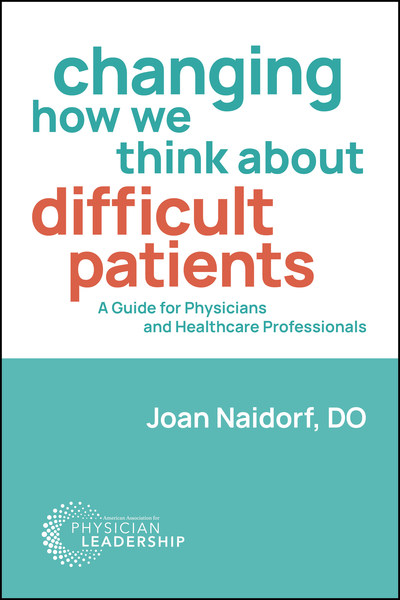WASHINGTON, Jan. 13, 2022 /PRNewswire/ -- Physicians enter their professions with the highest of hopes and ideals for compassionate and efficient patient care. Along the way, however, consistent problems arise in their interactions with difficult patients—some studies relate that physicians identify 15% or more of their patients as "difficult." What's to be done about this widespread problem?
The American Association for Physician Leadership (AAPL) announces the publication of Changing How We Think about Difficult Patients: A Guide for Physicians and Healthcare Professionals. Addressing a problem that is rarely discussed in the patient care context, Changing How We Think about Difficult Patients uses a multi-tiered approach to bring awareness and introduces simple, actionable tools that every physician, nurse, and care-provider can use to change their mindset and actions to avoid patient-associated burnout.
Chapter 1. We Can't Stand Some of Our Patients
- Negative Think
- The Hidden Curriculum
- Choosing our Thoughts with Think-Feel-Act
- Choosing our Thoughts with Intention
Chapter 2. What Makes a "Good" Patient?
- The Virtual Instruction Guide
- Four Core Ethical Principles of the Clinician-Patient Relationship
Chapter 3. What Challenges Anybody with Illness or Injury?
- Seven Fears Associated with Illness
- How "Good" Patients Handle the Challenges of Illness and Injury
Chapter 4. How Do Sick and Injured People Feel and Act?
- Six Common Reactions to Illness and Hospitalization
Chapter 5. On "Taking Care of the Hateful Patient"
Chapter 6. Responding to Dr. Groves: An Evolving Understanding
- De-escalation Strategies
- Responses in the Medical Literature
- Cultural, Structural, and Language Issues
Chapter 7. Our Least Favorite Patients
Chapter 8. How to Manage Our Thoughts
- The Think-Feel-Act Cycle
- Recognizing Our Preconceived Thoughts
- Actions That Move Us Toward Better Outcomes
- Awareness of Negative Thoughts
Chapter 9. Three Common Thought Distortions About Patients
- Arbitrary Inference
- All-or-Nothing Thinking
- Mirroring Emotions
Chapter 10. What We Think: Two Common Thought Distortions
- Resisting Reality
- Adopting a Victim Mentality
Chapter 11: Working Against Ourselves
- The Need to Seek Approval
- Personalization
- Perfectionism
Chapter 12. How We React
- Thoughts and Emotions
- Inactions and Negative Reactions
Chapter 13. Turning It Around
- Asking Useful Questions
- Finding What Has Gone Right
- You Can Handle This
Chapter 14. Getting Out of Our Own Way
- Accepting Reality
- Getting Out of the Victim Mentality
Chapter 15. How It Works
- Guiding our Thoughts Through a Common Scenario
- Decide How You Want to Feel
Chapter 16. Why Does It Matter?
- Retrain Your Brain
- Show Compassion, Feel Compassion
Chapter 17. No More Difficult Patients
- Learning the Skills
- When You Make a Mistake
- Show Compassion for Yourself
About Joan Naidorf, DO
Dr. Joan Naidorf is a board-certified emergency physician trained at the Philadelphia College of Osteopathic Medicine and Einstein Medical Center Philadelphia, with undergraduate schooling at University of Virginia. She practiced for nearly 30 years in the busy emergency departments of Inova Alexandria Hospital and Fort Belvoir Community Hospital in Virginia.
About the American Association for Physician Leaders
The American Association for Physician Leadership (AAPL) is focused on the personal transformation of all physicians, and through them the organizations they serve. With the goal of improving patient outcomes, workforce wellness, and a refinement of all healthcare delivery, AAPL has remained the only association solely focused on providing professional development, leadership education, and management training exclusively for physicians. Since its founding in 1975, AAPL has educated 250,000+ physicians across 40 countries—including CEOs, chief medical officers and physicians at all levels of healthcare. www.physicianleaders.org
Contact:
Nancy Collins
4104931799
[email protected]
SOURCE American Association for Physician Leadership

"difficult" - Google News
January 13, 2022 at 08:38PM
https://ift.tt/3GoYBw4
Changing How We Think about Difficult Patients: A Guide for Physicians and Healthcare Professionals - PRNewswire
"difficult" - Google News
https://ift.tt/2VWzYBO
https://ift.tt/3d5eskc
Bagikan Berita Ini
















0 Response to "Changing How We Think about Difficult Patients: A Guide for Physicians and Healthcare Professionals - PRNewswire"
Post a Comment